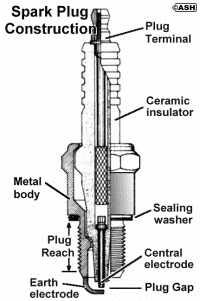A spark plug is a small cylindrical shaped device that can be fitted into an internal combustion engine’s cylinder head, that uses an electric spark to ignite gasoline in the chamber. As the engine runs, the spark plug runs this function thousands of times per minute, by converting its electrical energy into spark. The ignition coils amplify the electrical power from the battery and route it into each spark plug via ignition wires. The spark plug forces the electrical energy to jump the gap between the earth electrode and central cathode to create its sparks. The shape and design of the spark plug can be observed in Fig 1.
The first spark plug that worked reliably was designed by Oliver Lodge in 1903; it was named as such because they are simple plugs that are insulated and fit into the engine’s cylinder head to ignite the fuel and air mixture in the combustion chamber. Spark plugs are also responsible for transferring the heat outside the chamber (Geisler, 2009). To run the engine, there are four primary processes involved: An air-fuel mixture gets sucked by the piston moving downwards inside the cylinder to pull it inside the combustion chamber, then the fuel and air mixture gets compressed by the piston with its upward motion. The spark plug then ignites the mix by creating a spark, leading to an explosion in the chamber, which pushes the piston in the cylinder again downwards. The gases that were spent as a result of the combustion are then forced out by the piston (King, 2015).
During this process, it is the spark plug which is responsible for igniting the compressed mixture of air and fuel inside the chamber, and to remove heat from it. The plugs themselves do not create it; instead, they help to remove the heat from the chamber. The plug’s firing end’s temperature must be kept high enough to avoid fouling but low enough to avoid pre-ignition. It removes heat by transferring heat to the cooling system of the engine, thereby pulling unwanted thermal energy from the chamber by acting as a heat exchanger. It dissipates heat from its tip, and this ability is called as the heat range of the spark (Gspark, 2018).
The magneto or ignition coil generates a high voltage to which the plug is connected to. A voltage difference develops as the electrons flow from the coil between the side electrode and the center electrode. Currently does not pass as the air and fuel in the gap act as insulators, but the structure of the gases begins to change as the voltage rises further between the electrodes. The gas ionizes as the dielectric strength of the gases are surpassed by the voltage, letting the ionized gas act as a conductor to allow an electron flow transverse the gap. Usually, spark plugs require more than 20,000 Volts to correctly fire. The temperature of the spark’s channel can reach up to 60,000K as the current and electron flow rises across the gap. The ionized gas begins to expand quickly as the heat becomes intense, and produces a small explosion. The click sound of the spark is generated as a result of it, that works similar to how thunder and lightning work.
Spark plugs require being changed as they wear out. It depends on the engine to engine, but usually, it has to be replaced between 15 to 20,000 kilometers. Reduced engine performance and reduced fuel economy occur as a result of worn out plugs. Copper plugs usually have shorter lives than other plugs made from more durable and advanced materials like Platinum and Iridium, which often last four times longer than a copper plug but are more expensive. The material’s strength determines the durability and life of the plug. Understanding how a spark plug functions are essential for car owners as many engine problems could be related to it. One can find improved performance and efficiency if the plugs are replaced on time. Worn out plugs increase emissions from the car’s exhaust and cause the engine to misfire. A car’s check engine light may turn on in case the spark plugs are producing too many misfires and increasing the emissions. An efficient spark plug can reduce the voltage required in the car’s ignition system and decrease cold starts in the winter season.
Figure – Spark Plug Design (King, 2015)
References
Geisler, K. H. (2009, August 3). How Spark Plugs Work. Retrieved April 4, 2018, from How Stuff Works: https://auto.howstuffworks.com/spark-plugs3.htm
Gspark. (2018). How spark plugs work. Retrieved April 4, 2018, from The Green Spark Plug Company: http://www.gsparkplug.com/shop/how-spark-plugs-work/
King, R. (2015, February 25). How Spark Plugs Work. Retrieved from Mick’s Garage: https://www.micksgarage.com/blog/how-spark-plugs-work/






